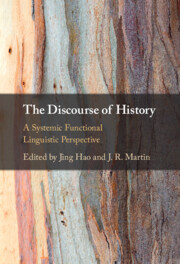Book contents
- The Discourse of History
- The Discourse of History
- Copyright page
- Contents
- Figures
- Tables
- Contributors
- Preface
- 1 Building Historical Knowledge through Language: A Systemic Functional Linguistic Perspective
- 2 Cultivating a Critical Gaze: Managing Technicality in Ancient History Teaching
- 3 Cultivating the Value of Democracy in History Teaching
- 4 Interpreting History: Valuing Events in a Postcolonial World
- 5 Coordinating Meaning: Scaffolding Teaching/Learning in Pedagogic Discourse
- 6 Explaining What Happened: Logical Metaphors in Spanish History Textbooks
- 7 Negotiating Values through Historical Evidence
- 8 Historical Empathy: Learning to Care about Others’ Suffering through Film
- 9 History in the Arts: Exploring the Past to Cultivate Students’ Gaze
- 10 Describing and Taxonomising the Phenomena of a Glorious Past
- 11 Representing Minority History in a Multi-Ethnic Country
- 12 Expressing Attitudes in Ancient Chinese History
- References
- Index
11 - Representing Minority History in a Multi-Ethnic Country
Published online by Cambridge University Press: 16 May 2024
- The Discourse of History
- The Discourse of History
- Copyright page
- Contents
- Figures
- Tables
- Contributors
- Preface
- 1 Building Historical Knowledge through Language: A Systemic Functional Linguistic Perspective
- 2 Cultivating a Critical Gaze: Managing Technicality in Ancient History Teaching
- 3 Cultivating the Value of Democracy in History Teaching
- 4 Interpreting History: Valuing Events in a Postcolonial World
- 5 Coordinating Meaning: Scaffolding Teaching/Learning in Pedagogic Discourse
- 6 Explaining What Happened: Logical Metaphors in Spanish History Textbooks
- 7 Negotiating Values through Historical Evidence
- 8 Historical Empathy: Learning to Care about Others’ Suffering through Film
- 9 History in the Arts: Exploring the Past to Cultivate Students’ Gaze
- 10 Describing and Taxonomising the Phenomena of a Glorious Past
- 11 Representing Minority History in a Multi-Ethnic Country
- 12 Expressing Attitudes in Ancient Chinese History
- References
- Index
Summary
This chapter explores the cultivation of the value of unity in a secondary school history textbook in China by examining the chapters on the founding of the Yuan dynasty in the thirteenth century by the Mongols. The study draws on the system of FIELD in register and APPRAISAL in discourse semantics. As for FIELD, in establishing static relations, the textbook applies shifts in the assigned temporal properties, which affords the reading of a continuous development of history made possible by geo-political unity. In construing dynamic relations, the historical activities are presented as linear, culminating in the unification of the Mongolian steppe and the whole country. In addition, activities are organised in linear series to construe assimilation of the various ethnic groups. As for APPRAISAL, the textbook positively appreciates the activity of unifying the Mongolian steppe and the country, and negatively appreciates wars and disunity. The analyses presented in this chapter show the crucial role of ideational resources (i.e. FIELD), as well as interpersonal resources (i.e. APPRAISAL) in aligning textbook readers into a community of shared values, which is an important aspect of representing minority history in a multi-ethnic country like China.
- Type
- Chapter
- Information
- The Discourse of HistoryA Systemic Functional Linguistic Perspective, pp. 271 - 299Publisher: Cambridge University PressPrint publication year: 2024

